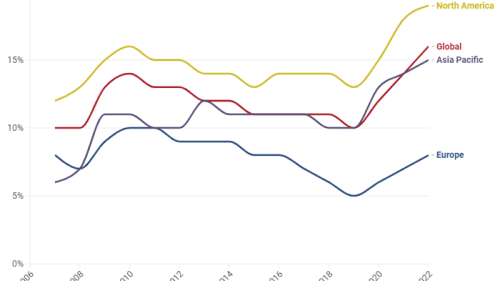With the economy growing ever so slowly, the consensus belief among 39 economists and analysts polled by ULI is that housing has once again assumed its place—some say “rightful place”—at the head of the economic train.
Not that income property will be doing poorly; projections for most commercial sectors are positive. But for the most part, the outlook among the more than three dozen contributors to the semiannual ULI Consensus Forecast, released September 26, is that the commercial markets will not do as well in the coming three years as was thought in March, when the initial ULI forecast was published.
For housing, however, forecasters are even more optimistic than they were six months ago. Indeed, with the forecasters noting that “most recent numbers have been strong,” the feeling is that the turnaround that has occurred this year can be expected to continue.
After bouncing around at near-record lows for the previous three years, housing starts are expected to rise from 430,600 in 2011 to 530,000 this year. The expectation is that starts will reach 657,000 next year and 800,000 in 2014. The forecasts for this year and next are higher in this edition of the survey than they were in March, but the estimate for 2014 is the same.
The forecasters are even more bullish on house prices. The average nationally was down in each of the last three years, according to the Federal Housing Finance Agency. But the consensus among the ULI survey participants is that the average price will rise 3.2 percent this year, 3.9 percent next year, and 5 percent in 2014.
In each instance, that is better than what was predicted in the March survey. But analysts participating in a teleconference discussing the latest results warned against reading too much into these numbers.
Jon Southard, managing director of global research and consulting at CBRE in Boston, noted that before the downturn five years ago, 800,000 starts was a low point. “We’re talking about just getting back to typical prerecession levels,” he said. “So while the market will feel very reasonable, we won’t really be in full recovery.”
Doug Poutasse, executive vice president of Bentall Kennedy in Seattle, said that while he hoped the prognosticators’ views about house prices were on target, such gains “would only begin to repair the damage” caused to household net worth and consumer confidence over the past five years. Prices could go up 4 percent in each of the next several years, he said, “and it would only get us back to where we were.”
On the commercial side, the survey found that transaction volumes can be expected to slip from $227 billion in 2011 to $223 billion in 2012 and then jump to $250 billion in 2013 and $275 billion in 2014. Issuance of commercial mortgage–backed securities (CMBS), a key source of financing for these deals, is projected to increase marginally, from $33 billion in 2011 to $35 billion this year, and then rise significantly to $45 billion next year and $60 billion in 2014.
However, these projections are all 10 to 20 percent below what they were just six months ago.
Poutasse said that while “a good number of transactions” are taking place, there could be more if potential sellers were not so reluctant to deal their properties. “A lot of owners are not ready to sell,” he said, making a point that was echoed by Jim Clayton, vice president of research at Cornerstone Real Estate Advisors in Hartford, Connecticut. “We need sellers to have transactions,” Clayton said.
Poutasse also pointed out that while the jump in CMBS issuances from 2011 to 2014 is almost double, $60 billion is “not necessarily a high number.” In the “good old days” from 2005 to 2007, he added, $60 billion “was just a good quarter. We need this, but we probably need for more than 60 to have a healthy capital market.”
The following is how the forecasters come down on the various income markets:
- Multifamily: Year-end vacancy rates can be expected to decline to 4.7 percent this year, hold there next year, and then rise a tad to 4.9 percent in 2014. These projections are even lower than those made six months earlier. Rental growth, meanwhile, is projected to rise to 4.8 percent this year, and then slip to 3.5 percent next year and 3 percent in 2014 as new supply hits the market.
- Industrial/warehouse: Analysts are less optimistic than they were six months ago, predicting modest declines in vacancies. But they look for stronger rental rates in the coming years.
- Office: Vacancies are projected to decline over the next three years at an even greater pace than thought six months ago. Rental rates will continue to strengthen, though not at as high a rate as projected in the original consensus forecast.
- Retail: High vacancy rates will continue, but some modest improvement in numbers similar to the March forecast should be seen. Rental rates are projected to be flat this year and then rise—again, though, not as quickly as believed six months ago.
- Hotel: Occupancy rates should be rising, as will revenue per available room.
Concerning the overall economy, the participants now believe the unemployment rate will come down more slowly than they thought six months ago, and they are “considerably more conservative” when it comes to job growth, said Dean Schwanke, executive director of the ULI Center for Capital Markets and Research.
Meanwhile, inflation is expected to remain in check, the analysts ventured. But interest rates will rise, resulting in an increase in borrowing costs.



